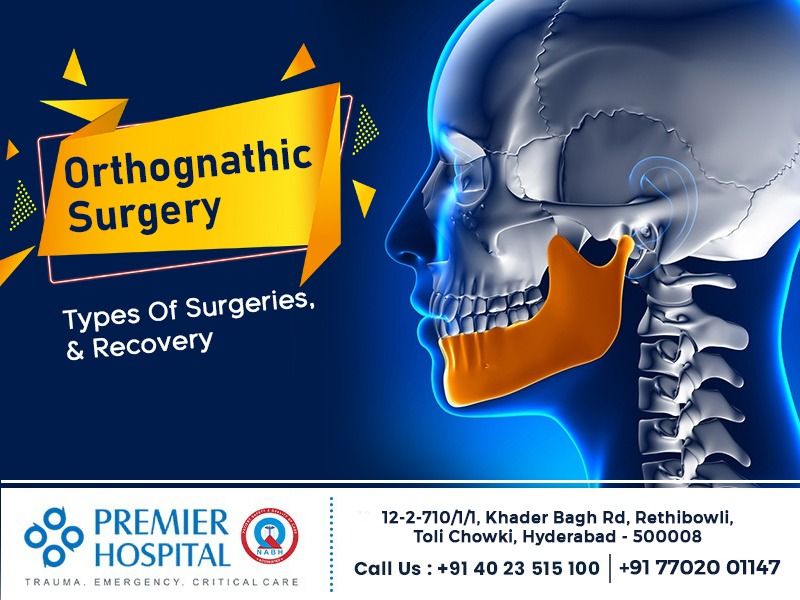by Premier Hospitals | December 14, 2021 |
The jaw consists of two parts, the upper jaw known as the maxilla and the lower jaw known as the mandible. Any severe problems associated with your jaws require orthognathic surgery, often referred to as jaw surgery. Jaws can become misaligned due to various reasons, resulting from trauma to congenital disabilities.
Why is jaw surgery done?
Genetic factors usually contribute to jaw irregularities. In addition, some childhood habits like sucking thumbs and mouth breathing can also have an impact on their behaviour.
Most of the people have bite issues, and surgery may be required to correct bite issues:
- Overbite — when the upper jaw extends far beyond the lower jaw
- Underbite — when the lower jaw extends forward beyond upper jaw alignment
- Open Bite — when the mouth is closed, the upper teeth do not meet the lower teeth
Other indicators for jaw surgery include:
- Misaligned jaws caused by other bite problems
- A lower chin & receding jaw
- Temporomandibular joint (TMJ) disorderÂ
- Jaw pain accompanied by severe headaches
- Breathing through the mouth continuously and dry mouth
- Obstructive sleep apnea
- Facial fractures or injuries
- Having trouble biting, chewing, or swallowing
- Have difficulty closing your lips without straining
- Congenital disorders, like cleft palate
- Conditions that affect your facial symmetry
Who are the Best Candidates for Jaw Surgery?
Since children's jaws aren't fully developed, they are usually good candidates for surgery. Early diagnosed misaligned jaws can be fixed simply with orthodontic treatment.
Treatment options for severe jaw misalignment become limited once the jaw reaches full development in adulthood. In such cases, orthognathic surgery is recommended to fix the problem.
Different Types of Jaw Surgery
Based on the severity of the misalignment and the position of the jaw, jaw surgeries are classified into different types of:
- Maxillary osteotomy (Upper Jaw Surgery)
- Mandibular osteotomy (Lower Jaw)
- Genioplasty (Chin Surgery)
- Arthroplasty (keyhole surgery
- Arthrocentesis
Maxillary Osteotomy
It is also called Upper Jaw Surgery which is performed to fix a severely receded upper jaw. The procedure involves making an incision in the gums directly above your upper teeth, cutting and moving the upper jaw to put it in a proper position.
In order to align the upper jaw, a small plastic wafer is attached to the teeth. To hold the jaw's position, it is fixed with titanium screws and metal plates. Upper jaw surgery is very effective in fixing an overbite, crossbite, and open bite.
Mandibular Osteotomy
It is also called lower jaw surgery, and it is one of the most commonly performed jaw surgery which is used to fix a severely receded lower jaw. An underbite is commonly treated with this surgery. The procedure involves adjusting the lower jawbone either forward or backwards to fix the patient's bite alignment.
Genioplasty
Often it is called Chin Surgery which is used to reposition or reshape severely misaligned lower jaws. Chin is the most commonly restructured part using this procedure. Oral-maxillofacial surgeons with special training and experience can perform it.
Temporomandibular Joint Dysfunction Surgeries
Temporomandibular joint disorder or dysfunction (TMD) is a condition that causes severe pain in the jaw muscles due to damage to the articular disc that cushions the jaw joint. Open surgery is commonly used to treat TMD.
Arthroplasty: Open-joint arthroplasty, also known as keyhole surgery, is the most common procedure used to treat temporomandibular joint disorders (TMD). In this procedure, an arthroscope with a small camera head is sent into the joint through a small incision. This procedure relieves pain by removing scar tissue that surrounds the joint.
Arthrocentesis: it is a minimally invasive surgical procedure often called joint aspiration that involves injecting fluid into the TMJ using small needles. As a result, the joint can be lubricated, and any inflammation-related debris will be cleansed.
The surgeon can also reposition or realign the jaw during this procedure and inject steroid medications into the joint.
Recovery & Aftercare
Most people are able to return to their homes the next day following the jaw surgery. It may take around 2 months for the bones to heal fully.
A jaw surgery recovery timeline consists of the following steps:
- Patients might feel some pain & soreness during the first 2 to 3 weeks following surgery. However, this is totally normal.
- After 3 weeks, swelling should subside. In some rare cases, swelling may take months to subside.
- It's important to get more sleep, stay hydrated, and make sure you follow your surgeon's post-operative instructions.
- The maxillofacial surgeon might recommend some pain medication and antibiotics when you are discharged from the hospital. Make sure you take them as instructed.
As there are different types of jaw surgery, an oral and maxillofacial surgeon will plan out a specific procedure to address your condition.
The majority of jaw surgeries are safe, but there are few risks related to them. Be sure to ask your surgeon about them before the procedure. There are several factors that influence the cost of jaw surgery, such as the surgery type, severity of the problems and specific surgeon. To know details about the procedures, consult Dr. Abhinand Potturi, the best maxillofacial surgeon in Hyderabad. Chief Consultant, Department of Maxillofacial & Reconstructive Surgery, incharge - Oral Cancer Screening clinics at Premier Hospital, Mehdipatnam, Hyderabad.



















